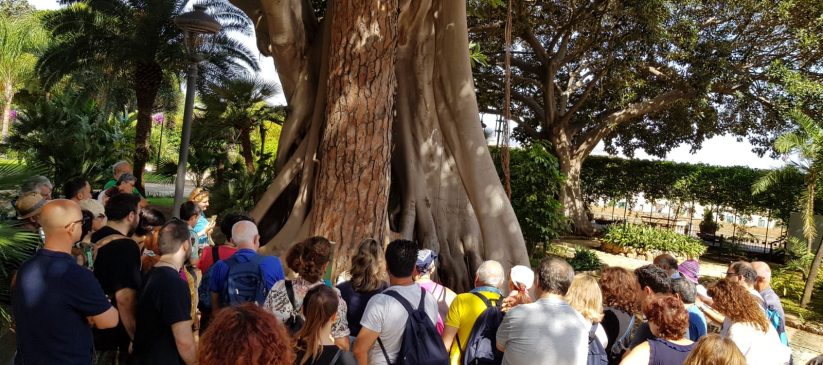
This was the announcement of the General Manager of the Federico II Foundation, Patrizia Monterosso, during the first day of Real Verde (Royal Green). June 2nd, 2018. “From today the Royal Gardens of the Royal Palace can be appreciated and enjoyed by those visitors who love nature. One of the objectives to be pursued is to enhance the cultural heritage and the ‘monuments of nature’, first of all the gigantic Ficus macrophylla which embraces a pine tree and lives in the company of very rare plants “. The president of the Ars (Sicilian Regional Assembly) and of the Federico II Foundation, Gianfranco Miccichè, spoke these word during the the first day of Real Verde (Royal Green) at the Gardens of the Royal Palace. “They have been closed for years, except for some sporadic events. Now – added Patrizia Monterosso, Manager of the Federico II Foundation – once and for all we open the Royal Gardens, which are finally part of the tourist route that already includes the Palatine Chapel, the Royal Apartments and the exhibitions held in the Duke of Montalto Halls”.
With this announcement yesterday evening opened the first edition of Real Verde (Royal Green), three days dedicated to the “monuments of nature”, taking place in Palermo with the epicenter at the Royal Gardens of Palermo, organized by the Ars (Sicilian Regional Assembly), the Federico II Foundation, Legambiente with the collaboration of the Museum System of the University of Palermo. The Royal Gardens of the Royal Palace are a green lung in the heart of Palermo’s UNESCO quadrilateral, ready to show their beauties to visitors from all over the world (more than half a million per year in constant increase annually visit the Monumental Complex). A garden that will be enjoyed as a museum: plants and trees as paintings thanks to the presence of rare and exclusive plants. Each “artwork” has its caption, just like in an exhibition. And if the Byzantine mosaics and the Christ Pantocrator are among the major attractions of the Palatine Chapel, the Ficus Macrophylla embracing a domestic pine is the soul of this garden, which after the recovery concluded in 2016 is now definitely “museum-like”: a “talking” garden: as the tourist internalizes historical notions about the Royal Palace, in the same way he must be able to read the garden and discover the countless rare specimens. Among the guests, the poet and writer Tiziano Fratus, who coined the concept of Homo radix.
“This garden – said Fratus – has a close link with those of Palermo because of the presence of the essences that can be seen in other gardens. As if there were a large divided and distributed forest that is a little magic and the sensational element is both the presence of the hybrid architecture of the Palace but the most interesting aspect, at least regarding the trees and vegetation, is this meeting, this marriage between the great Pine and the great Ficus that have been embracing, now for some decades, and this is unique. There are very few cases of this around Italy. A fortuitous, curious meeting that contradicts a bit the beliefs that we have when talking about nature and trees”.
Great interest and curiosity for the guided tour to discover the Gardens and their rare plants explained with passion by the curator of the Botanical Gardens, Manlio Speciale, who in 2016 was responsible for the restyling of the Royal Gardens.
The visit is also repeated today, June 2nd, and tomorrow, June 3rd, at 5 p. m. (free admission). Dr. Speciale explained to the participants that the new Royal Gardens represent the first “late romantic” style garden.
The garden, which rises above the Saint Peter’s bastion, despite its enormous potential, over the past 50 years had lost the identity it has now found.
The recent recovery has made it the first late romantic or post-gardenesque garden. A place of stylistic arrival of the historic gardens with plants inserted with the desire to decorate and embellish, similarly to what Whitaker did. The garden is therefore unique. A style that combines different materials, aesthetic lines prior to this style, in a sort of expressionism. In fact, we find romantic glimpses such as the fern and succulent hills, the Mediterranean garden that recalls the 17th and 18th centuries. And finally, the garden-style portion with the irregularly shaped flowerbeds typical of post-enlightenment, covered with grass, from which the plants emerge as if they were statues. This blend of styles in total harmony creates the late romantic, which is characterized by the presence of very rare specimens, exclusive to this garden. Among these we mention the Dioon mejiae, the Encephalartos whitelockii, the Encephalattos arenarius, the Ceratozamia kuesteriana. But also the Sabal uresana and unusual varieties of plumeria. The new project of the Royal Gardens would certainly have pleased Frederick II, nicknamed the naturalist emperor thanks to his love for nature. In the three days of Real Verde (Royal Green), in addition to the gardens, the Palatine Chapel and the “Sicilië, Pittura Fiamminga” (Sicilië, Flemish painting”) exhibition, are going to remain open from 8.15a.m. to 9p.m. (last admission at 8p.m.). Today there is an event dedicated to urban naturalistic trekking with Professor Rosario Schicchi, director of the Botanical Gardens of Palermo, who describes the monumental trees, from the Fossa della Garofala to the Royal Gardens of the Royal Palace, passing by the Sycamore of via Merlo, the Ficus of Villa Garibaldi, Goethe’s Sycamores of Villa Giulia to arrive at the Botanical Gardens.
Courtesy translation Elettra La Duca